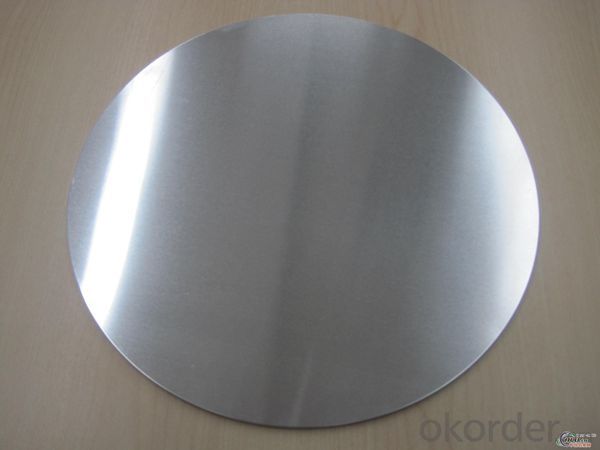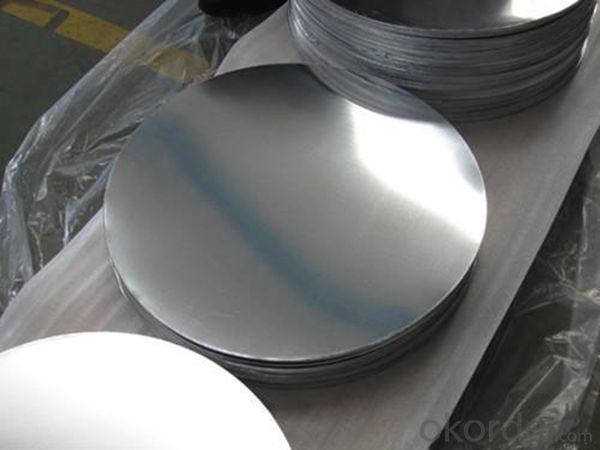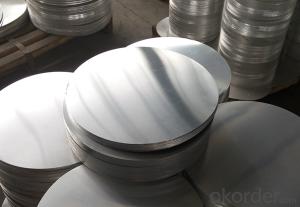Mill finish Aluminum wafter for cooking utensil
- Loading Port:
- Tianjin
- Payment Terms:
- TT OR LC
- Min Order Qty:
- 5 m.t.
- Supply Capability:
- 600 m.t./month
OKorder Service Pledge
OKorder Financial Service
You Might Also Like
Item specifice
wafter for cooking utensil
Professional aluminum product manufacturer
We have our own plant , Laboratory and engineer
Over 100 models can totaly satisfy your request
As powerful and stronger factory, our aluminum quality is very stable and reliable
2 years warranty period
Specifications:
Thickness:0.5mm-6.0mm
Width:100mm-900mm
Surface:Bright & smooth surface, not defects like white rust, oil patch.
Product Information :
Product | Aluminum Circle |
Alloy | 1050 1060 1070 1100 1200 |
Temper | O, H12, H14, H18 and H24... |
Thickness | 0.5mm-6.0mm |
Diameter | 100mm-900mm |
Lead Time | Within 30-45 days after receiving deposit |
Packing | Standard Exporting wooden pallets or based on customer requirement |
Material | Using high-tech machinery utilizing premium grade Aluminium Coil. Customized according to the needs and demands of the clients these can be availed at different technical specifications. |
Surface: | Bright & smooth surface, free from defects like white rust, oil patch, edge damage. |
Application | Aluminium Circles are used in Reflective Sign Boards, Road Furniture, Utensils, Sand witch Bottom, Cooker, Non-Stick etc. |


- Q:How to solve the loose bonding of aluminum sheet and silica gel?
- Bonding silicone rubber needs surface treatment, after using silicone rubber surface treating agent of Kuer , you can bond them with 4211 adhesive.
- Q:What will affect the performance of the aluminum ingot in the process of casting?
- In our daily industrial raw materials called aluminum ingot, according to the national standard (GB/T1196-2008) should be called "remelting with aluminum ingot", but we are used to "aluminum ingot"". It is with the alumina cryolite produced by electrolysis.
- Q:What are the different joining methods for aluminum sheets?
- There are several different joining methods for aluminum sheets, each with its own advantages and considerations. Some of the common joining methods for aluminum sheets include: 1. Welding: Welding is a popular method for joining aluminum sheets. It involves melting the aluminum sheets and fusing them together with the help of a filler material. Welding can be done using various techniques such as gas tungsten arc welding (GTAW), gas metal arc welding (GMAW), or laser welding. It provides strong and durable joints, but it requires skilled labor and can be time-consuming. 2. Adhesive bonding: Adhesive bonding is another method commonly used for joining aluminum sheets. It involves applying a specialized adhesive or glue to the surfaces that need to be joined. Adhesive bonding offers several advantages such as excellent corrosion resistance, uniform distribution of stress, and the ability to join dissimilar materials. However, it requires proper surface preparation and can be affected by temperature and humidity. 3. Mechanical fastening: Mechanical fastening involves using various mechanical fasteners such as bolts, screws, rivets, or clips to join aluminum sheets. This method is relatively simple, cost-effective, and allows for easy disassembly if required. However, it may create stress concentrations around the fasteners, and the joints may not be as strong as those created by welding. 4. Friction stir welding: Friction stir welding is a relatively new joining method that is gaining popularity for aluminum sheets. It involves rotating a non-consumable tool along the joint line, generating friction and heat that softens and joins the aluminum sheets. Friction stir welding offers benefits such as high joint strength, low distortion, and a defect-free weld. However, it requires specialized equipment and is limited to certain sheet thicknesses. 5. Clinching: Clinching is a cold joining method that involves deforming the aluminum sheets using a punch and die without melting them. The sheets are pushed together under high pressure, creating a mechanical interlock. Clinching is a fast and cost-effective joining method that does not require additional materials, but it may result in visible deformation on the surface. It is essential to consider factors such as joint strength, corrosion resistance, aesthetics, production cost, and specific application requirements when choosing a joining method for aluminum sheets. Each method has its own advantages and limitations, so selecting the most suitable technique depends on the specific needs of the project.
- Q:Are aluminum sheets resistant to rust?
- Indeed, the resistance of aluminum sheets to rust is remarkably high. This is due to the natural formation of a protective oxide layer on the surface of aluminum when it comes into contact with air, thereby hindering further corrosion. In contrast to iron or steel that can rust in the presence of moisture and oxygen, aluminum does not necessitate any supplementary coatings or treatments to safeguard against rust formation. Consequently, aluminum sheets are widely favored across various sectors such as construction, automotive, and marine industries, where the prevention of rust is imperative.
- Q:An aluminum engine block has a volume of 4.77 and a mass of 12.88 .
- For the best answers, search on this site okorder (2.7 g / cm?) x (1 kg / 1000 g) x (100 cm / 1 m)? = 2700 kg / m?
- Q:are there any hazards in aluminium?
- Some. The chemical aluminum can get into your blood accumulate. Years ago, there was a study of weather blood aluminum was the cause of Alzheimer disease. Was proven not to be. But that study helped to reduce the amount of aluminum in deodorant sticks.
- Q:Are 101 aluminum sheets suitable for high-temperature applications?
- No, 101 aluminum sheets are not suitable for high-temperature applications as they have a low melting point and may deform or melt under high temperatures.
- Q:Can aluminum sheets be anodized?
- Yes, aluminum sheets can be anodized. Anodizing is an electrochemical process that creates a durable, corrosion-resistant layer on the surface of aluminum. This process can be applied to aluminum sheets to enhance their appearance, increase their resistance to wear and tear, and improve their overall performance.
- Q:Can aluminum sheets be used for heat exchanger fins?
- Yes, aluminum sheets can be used for heat exchanger fins. Aluminum is a commonly used material for heat exchanger fins due to its excellent thermal conductivity, lightweight nature, and resistance to corrosion.
- Q:How do I join aluminum sheets together?
- To join aluminum sheets together, various methods can be utilized depending on the specific application and desired outcome. Here are several commonly employed techniques: 1. Riveting: Aluminum sheets can be joined by using rivets, which are small metal fasteners. This involves drilling holes in the sheets and then inserting the rivets, which are permanently secured by deforming or compressing them. Riveting is a widely used and durable method for joining aluminum sheets. 2. Welding: Aluminum welding can be accomplished through methods such as gas tungsten arc welding (GTAW), gas metal arc welding (GMAW), or laser welding. These techniques involve melting the aluminum at the joint, allowing it to fuse and create a strong bond upon cooling. Welding necessitates specialized equipment and expertise, but it provides a robust and permanent joining solution. 3. Adhesive bonding: This method employs industrial-grade adhesives specifically designed for bonding aluminum. The adhesive is applied to the surfaces to be joined, and then the sheets are pressed together and allowed to cure. Adhesive bonding results in a clean and aesthetically pleasing joint, although it may not be suitable for high-stress applications. 4. Mechanical fasteners: Another option for joining aluminum sheets is the use of screws, bolts, or nuts. This method entails drilling holes in the sheets and employing fasteners to secure them together. Mechanical fasteners offer a strong and adjustable joint, making disassembly easier if required. Before selecting a joining method, it is important to consider factors such as the strength requirements, appearance, ease of assembly, and disassembly of the application. Additionally, adhering to safety guidelines and seeking professional advice is essential if uncertainty or lack of experience with joining aluminum sheets exists.
1. Manufacturer Overview |
|
|---|---|
| Location | |
| Year Established | |
| Annual Output Value | |
| Main Markets | |
| Company Certifications | |
2. Manufacturer Certificates |
|
|---|---|
| a) Certification Name | |
| Range | |
| Reference | |
| Validity Period | |
3. Manufacturer Capability |
|
|---|---|
| a)Trade Capacity | |
| Nearest Port | |
| Export Percentage | |
| No.of Employees in Trade Department | |
| Language Spoken: | |
| b)Factory Information | |
| Factory Size: | |
| No. of Production Lines | |
| Contract Manufacturing | |
| Product Price Range | |
Send your message to us
Mill finish Aluminum wafter for cooking utensil
- Loading Port:
- Tianjin
- Payment Terms:
- TT OR LC
- Min Order Qty:
- 5 m.t.
- Supply Capability:
- 600 m.t./month
OKorder Service Pledge
OKorder Financial Service
Similar products
New products
Hot products
Related keywords





























